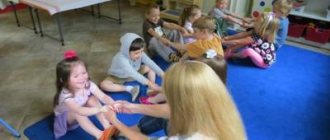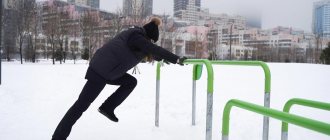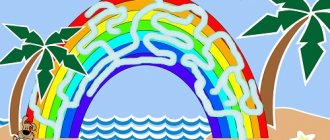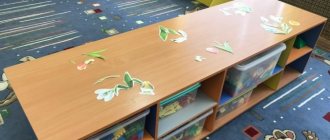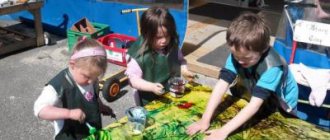Thematic lesson on physical education in the senior group “Journey to the land of health”
Thematic lesson on physical education in the senior group “Journey to the land of health”
Author: Kashtanova Yulia Andreevna Physical education instructor
MDOBU "Combined kindergarten No. 20"
Summary of a story-based physical education lesson in a group of general developmental orientation for children 5-6 years old “Journey to the Land of Health”
Goal: to reinforce children’s ideas about a healthy lifestyle
and apply them in everyday activities.
Objectives: - bring joy to children in motor and play activities; — create conditions for generalizing children’s basic valeological knowledge
, the ability to use this knowledge for your health; — develop children’s interest in physical education and sports, coordination of movements, spatial orientation, strength, agility, courage, endurance.
Equipment: Envelope, massage paths, 16 sandbags, 2 targets, 16 small yellow balls, 2 boxes, 2 arcs, 8 hoops, 6 “bumps”, doll, “Hygiene items” - 2 soaps, 2 wet wipes. , toothpaste 2 pcs., toothbrush 2 pcs., towel 2 pcs., comb 2 pcs., handkerchief 2 pcs., shampoo 2 pcs., modules.
Introductory part.
Children enter the hall and stand in a line. Instructor: Hello, guys! Children: Hello. Child: Group! Be equal! Attention!
Instructor: Guys, why do you come to the gym? Physical education instructor
: Yes, guys, all this is true. A letter arrived at our kindergarten. It is very strange, the Envelope, it does not look like an ordinary envelope. Want to know who sent you hello?
(The instructor reads the letter)
Hello, friends! Get ready to hit the road! Go to the land of health.
Instructor: Guys, we are invited to the land of health. What do you think health is? Children's answers
. Ready to go on a journey? Pay off the first and second! Right! March behind the guide in one column! Let's go ahead, many discoveries await you. (regular walking) We’ll walk on our tiptoes, We’ll cross to the other side (walking on our toes) We’ll cross the obstacle in an instant – And jump, jump, jump over the bumps (jumping on two legs) We put our hands on the floor And quietly crawl (crawl on our hands and knees ) Slow running, stopping. We walk again, we walk, we don’t lower our heads, we breathe evenly, deeply. You see how easy it is to walk.
Main part
Instructor: “So we have come to the land of health.” We are scattered. We need exercise, and it is important for everyone! Get ready for some fun exercises, kids!
Charging with music.
Instructor: Health is fine! Children: Thanks for exercise! Instructor: Are you ready to continue our journey? And so that we don’t go astray, look at the path! (Children walk along the massage path) We will walk along the path and stretch our legs. Stand in one line. Guys, can you hear the music? Who is this?
1. I suggest you fight with insidious microbes. "Get into the germ." Children take turns throwing sandbags at the target.
2. “Vitamins.”
To be healthy, you need to eat right and take vitamins. I suggest you fill the box with vitamins. Children take turns overcoming the obstacle course and carrying small balls into the box. (obstacle course: arcs, hoops, arcs) Guys, look, grimy girl, where did you get your hands so dirty? Black palms, tracks on the elbows. Dirty girl: (crying). They don't let me into the land of health! I don’t know why. Instructor: Guys, we will show the girl what items we need to be neat.
3. Relay race “Hygiene items”.
Children take turns running like a snake to the cube, putting the object down and running back. Well done guys, you completed the task. Let's move on. Children walk around the hall to the music. And now it’s time for us kids to play. To be healthy you need to be friends with sports. Outdoor game
"Figures-types of sports." And now it’s time for us kids to play. To be healthy you need to be friends with sports. To the music you make jumps, as soon as the music ends you need to depict the figure that is shown on the cards. (2 times). Making the game more difficult. Pink cards for girls, blue cards for boys.
An outdoor game with cards.
At a signal, children draw the figures shown on the card. Guys, do you smell something tasty, probably in kindergarten
dinner. Inhale through your nose, exhale. (3 times). It's time for us to go to kindergarten. We made a circle. In order to get back to kindergarten, I suggest you board the airplane and hit the road. We sat down cross-legged.
Final part
Relaxation “Clouds”
Imagine a warm spring evening. You are sitting on an airplane carpet looking at the clouds floating in the sky - such white, large, fluffy clouds in the blue sky. Everything around is quiet and calm, you feel warm and comfortable. With each inhalation and exhalation, you begin to slowly and smoothly rise into the air, higher and higher, towards the very clouds. Here you are swimming up to the largest and fluffiest, most beautiful cloud in the sky. Closer and closer. And now you are already lying on this cloud, you feel how it gently strokes you, this fluffy and tender cloud. You feel good and pleased. But then a cloud descended over you from kindergarten. Smile at your cloud. Stretch and on the count of three, open your eyes. You had a good rest on the cloud. Guys, sports are very necessary, we are strong friends with sports! Sports assistant, sports health! Sports game! Physical training! Instructor: Our journey has ended.
A girl doll comes in: Here I am again. Thank you for helping me, now I am allowed into the land of health. And I want to give you a gift. (The girl gives a gift to the children.)
Instructor: Right! Follow the guide to the group with a march!
Thematic physical education classes with children in a preschool educational institution.
Thematic physical education classes with children in a preschool educational institution.
Modern preschool educational institutions use different forms of physical education classes. One of these forms is subject-based physical education classes. Story-based physical education classes help preschoolers develop learning skills in a fun way. They teach children to remember the plan of action and be guided by it while performing physical exercises in a playful way. They develop value judgments in children: achieving good results in front of all children instills confidence in the child and creates a joyful mood, awareness of their abilities and capabilities in realizing common interests, and shared joy is double joy.
Successful solution of educational problems is possible only if the requirements for the health-improving orientation of thematic physical education classes are met. Ensuring high physical activity of children during story-based activities, observing scientifically based loads on all organs and systems of the child can ensure an effect in his physical development and health promotion.
Specially organized subject-based physical education classes with the entire group ensure the passage and mastery of program material in a certain sequence; allow, as necessary, to repeat and consolidate motor actions. Training is carried out systematically. Classes are built according to a specific plot plan and therefore allow you to dose the physiological load, gradually and carefully increasing it, which helps to increase the body's endurance. Preparing the body to perform complex movements helps prevent injuries when performing them.
The plot lesson includes elements of walking and running in the introductory part of the lesson, general developmental exercises with and without objects, basic movements, outdoor and sports games in the main part, breathing exercises, finger games and low-intensity games in the final part. Classes of this nature are distinguished by interesting content, games, a joyful atmosphere, positive children's emotions and beautiful figurative speech of an adult.
Using story-based activities helps in solving the following problems:
- consolidate and improve children’s motor skills in a playful way;
- development of mental abilities and emotional sphere;
- development of musical and rhythmic abilities,
- nurturing interest and need for systematic physical exercise.
- educate and develop children's creative abilities and imagination
- promote interest in improvising various actions during the lesson.
All plot activities can be divided:
1. Plot-based physical education classes.
Goal: Acquisition of a variety of motor skills through
imitative image.
Throughout the lesson, different movements have different images or one image is embodied in different movements. These can be “bunnies”, “bear cubs”, “puppies”
2. Game-based physical education classes.
Goal: Overcoming various problematic situations, cultivate physical and psychological qualities. Teach children to set a goal and achieve it a). Through the game “Visiting Grandma” or “Driving along the Road,” children learn to overcome game obstacles in performing movements, spatial orientation, etc.
b) Through a story game with a specific purpose, for example, “Let's help the animals wake up the sun,” children are initially given a goal, to achieve which it is necessary to overcome motor difficulties and be able to resolve a problem situation.
3. Thematic and thematic physical education classes.
Plot-thematic classes, in turn, can be divided into three types:
- Thematic and thematic physical education lesson on fairy tales and literary works.
The purpose of such classes is to teach how to navigate problem situations, to develop creativity, fantasy and imagination in children; overcome motor difficulties,
a) The lesson can be based on the plot of one fairy tale, literary work, for example “Geese and Swans”, “Kolobok”, “Wolf and Little Goats”
b) The lesson is based on a meeting with characters from different fairy tales, for example, “Journey to the Land of Fairy Tales.”
c) Throughout the entire lesson, there is one fairy-tale character, for example, Carlson, Pinocchio, Doctor Aibolit.
- Thematic and thematic physical education activities related to seasonal phenomena in nature and social life.
These classes contribute to the cognitive development of schoolchildren and create excellent conditions for improving basic movements; stimulate motor activity, regulate it, thus ensuring the harmonious development of the child.
Cognitive development of preschoolers is carried out unobtrusively, through play. Preschoolers will learn about the peculiarities of natural phenomena. Thus, in the lesson “Journey to the Autumn Forest,” children will learn that the squirrel makes provisions for the winter (nuts, mushrooms), and the hedgehog is preparing for hibernation. In the classes “Walk in the Autumn Forest”, “Spring Has Come”, children learn that the bear is a forest animal. He goes to sleep in a den in the fall until spring. In the lesson “Bear-athlete” - that the bear is strong, can climb trees, run, swim.
Activities such as “Sailors”, “Postman”, “We are athletes”, “Circus” help children consolidate their knowledge about the work of adults and the phenomena of social life.
- Thematic and thematic physical education classes with one manual.
In classes, children will learn about the variety of ways to use any sports aid in various types of motor activity (jumping, throwing, balance, running).
The purpose of such classes is:
-Development of motor skills and abilities; physical qualities.
— Children learn to use the same object in different situations[5]. Preschoolers fantasize and come up with various exercises, which contributes to the development of imagination, self-expression, and creative activity.
Classes with one manual are used in all age groups; they are aimed at training and consolidating movements. These could be activities such as “Multi-colored ball”, “Magic hoop”, “Magic wand”, “Ladder”, “Magic jump rope”.
Classes with non-standard sticks are very interesting, which include the following types of activities: drill exercises (different types of walking with a stick; walking and running with stepping over sticks; running with jumping over a stick); general developmental exercises; laying out a path of sticks and walking and running along this path, jumping over it; active play with sticks, exercises for developing fine motor skills of the hands - massage, laying out various objects from sticks (a circle, a house, the sun, a car, etc.)
The use of imitation and imitation techniques facilitates the process of memorization, mastering exercises, increases the emotional background of the lesson, promotes the development of thinking, imagination, creative abilities, and cognitive activity.
Movements associated with some image or plot captivate children; the image encourages them to perform imitative movements, which preschoolers really love. Different roles for children mean different motor tasks. For example, children - “mice” - look out of their holes, walk with small steps, children - “kittens” - arch their backs, catch their tails, play with a ball, while the “mice”, scared, watch them. Children in the role of bunnies learn to jump, in the role of athletes they learn to exercise with a stick, in the role of sailors they learn to “walk and crawl on a high and slippery deck.
Such activities develop children's creativity, fantasy, and imagination. Literary heroes teach children to overcome motor difficulties in achieving goals and navigate problematic situations. This type of activity is valuable because children reveal themselves in unexpected ways, for example: they show artistry, musicality, and independence. This is one of the reasons for conducting story-based physical education classes.
Physical education classes in plot form begin with an emotional story in which an imaginary situation is set, the conditions for accepting the role are revealed to the children, and the sequence of exercises and their content are communicated. In each age group, I try to use a variety of techniques to create play motivation that encourage children to enthusiastically perform physical exercises: these include riddles about animals, about natural phenomena, artistic expression, and magical transformations into different characters; use of toys, masks. When selecting exercises, the age characteristics of children are taken into account, and their level of physical fitness is also taken into account.
The variety of standard and non-standard equipment in the classroom, the presence and use of natural materials contributes to better organization and increased motor activity of children.
Story classes are held 1-2 times a month. The topics of such classes depend on long-term thematic planning in kindergarten. Thus, plot-based physical education classes allow you to independently find the optimal ways to perform basic movements and general developmental exercises; they contribute to the development of physical qualities, the development of creativity, and mental processes.
These classes open up wide opportunities for working with children, create favorable conditions for improving basic movements, promote the mental and physical development of a preschooler, stimulate motor activity, regulate it, thus ensuring the harmonious development of the child.
